|
Monday, December 31, 2007
Recalls, Class Action Lawsuits
Monday, November 26, 2007
Housing Safety for the Elderly
As we age our senses are not as sharp and the loss of the sense of vision, smell, hearing and touch can result in injury. With the frequent bone loss of older individuals, the risks from falling are magnified. A simple fall can result in a serious incapacitation injury that can lead to loss of independence. These tips while intended for elderly safety apply to all people, especially children and pets.
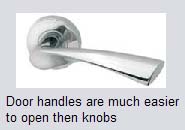 Security
SecurityCheck doors and locks for easy operation and security. All doors should have secure deadbolts that do not require a key from the inside. We recommend 180 degree peepholes at the appropriate height and good porch lighting. You might consider alarm systems for peace of mind.

Phones
Put emergency contact information, doctors, hospitals, pharmacy, etc next to the phone. Make sure the address is listed along with family contact information. Remember that most cordless phones will not work during a power outage, so always have at least one non powered corded phone.
Safety Equipment
Test all smoke alarms, and if they have them, change the batteries on a regular cycle like daylight savings time change. If the residence has
 any combustion appliances (furnace, hot water, fireplace, stove, ect.) or and attached garage we also recommend carbon monoxide detectors. We recommend that you locate any safety equipment your building may have, like fire extinguishers, fire escapes and central alarms. Consider installing extinguishers inside the home and near any barbeques and garages. Read more Fire Safety Tips from the Consumer Product Safety Commission.
any combustion appliances (furnace, hot water, fireplace, stove, ect.) or and attached garage we also recommend carbon monoxide detectors. We recommend that you locate any safety equipment your building may have, like fire extinguishers, fire escapes and central alarms. Consider installing extinguishers inside the home and near any barbeques and garages. Read more Fire Safety Tips from the Consumer Product Safety Commission.Kitchens
Check the lighting assuring that it is adequate to clearly see cooking and working areas. Check location of lighting switches, they should be easily assessible near the doorways. Hot water can severely scald, so assure the water temperature is set no
 higher then 120 degrees. Single conrtol faucets are less likely to cause burns. The flooring should be easily cleaned, not slippery, and any rugs or pads should have non skid backing to help prevent falls. Controls for the range and oven should be in front or beside, not in back where you would have to reach over a burner. All kitchens should have GFCI protected outlets within 6 feet of water. These should be tested regularly to assure they are working. A circuit properly protected by a GFCI can prevent 2/3 of all electrocutions.
higher then 120 degrees. Single conrtol faucets are less likely to cause burns. The flooring should be easily cleaned, not slippery, and any rugs or pads should have non skid backing to help prevent falls. Controls for the range and oven should be in front or beside, not in back where you would have to reach over a burner. All kitchens should have GFCI protected outlets within 6 feet of water. These should be tested regularly to assure they are working. A circuit properly protected by a GFCI can prevent 2/3 of all electrocutions.Halls and Rooms
Inspect all stairs and halls for trip hazards at carpet/flooring edges, thresholds, cords, etc. Look around for sharp edges on furniture, trim, shelving and heaters that could be hazardous in case of a fall. Check for good lighting and switch locations.

Stairs
Since so many injuries occur on stairs, we have dedicated a web page to stair safety. You will find more complete safety info there. Some of the tips include..
1) Continuous handrails:
Consider installing secure hand raills on both sides of steps. They should be at the correct height, easy to grasp and solid construction.
2) Vertical balustrades:
These are to assure there is no opening greater then 4"
3) Even Treads, to prevent trips
4) Good Lighting, with light switches at top and bottom of stairs.
5) Closed risers, these are much less likely to cause a trip.
6) Clear approaches
Read the rest of our stair tips here:
Sources:
Home Safety Checklist for the Elderly
North Carolina State University, North Carolina A&T State University, U.S. Department of Agriculture
Smart Housing Safety and Security Booklet
Department of Housing, GPO Box 690,Brisbane Q 4001

If you find this information useful, don't keep us a secret! List us on any of your favorite networking / bookmarking sites

Monday, September 17, 2007
With the coming colder and wetter weather it is time to think about maintenance on the home
Always use extreme care when using ladders or working on roofs, especially around power lines. If you are unsure in any way consult a professional to maintain theses items.
 Gutters & Downspouts
Gutters & Downspouts
It seems obvious that if your gutter systems are not working properly water will likely damage some part of the structure. Make sure all gutters are cleaned usually 2 times a year, more depending on the number of trees dropping debris, etc. They should be all properly attached, no sagging low spots, with proper downspouts & splash blocks or other suitable drains. Water should discharge away from the home. Look around the home for areas of splash-up. This is caused by water running off the roof or gutter and causing mud to splash up onto the house.
 Roofs
Roofs
Examine all penetrations (fasteners, utility holes, skylights, vents, etc) on your roof. Since tar lasts only a few years, we recommend that it be re tarred on regular intervals, depending on the products conditions. Check for cracking and shrinkage of material, this can be a potential leak point..
 Cleaning
Cleaning
Some homes have trees that drop extensive debris on them requiring regular maintenance. Debris piled around skylights, chimneys, valleys and drains can cause water to backup under roofing and flashings to cause leaks.
Chimneys
Inspect the crown, flashing, masonry, cap, etc. Have wood fired appliance chimneys examined and cleaned regularly, especially if you burn a lot.
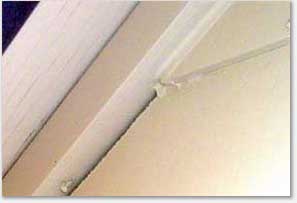 Caulking
Caulking
Go around the entire exterior with a critical eye on all caulked areas. Fill and paint as necessary to maintain maximum protection from water and cold. A dry, tight house is far less likely to have problems with structural pests. Common areas that frequently need more caulk include: doors, windows,utility holes, gaps in siding, corners, vents, nail holes, fascias, soffitts, trim, etc.
Carefully note the condition the various painted surfaces on your structure. Look at each type of surface, wood, concrete, decking, rails, etc. Most homes paint condition will vary widely depending on the exposure to weather, landscaping damage, and different types of materials. All materials painted surfaces will fail at different rates. NOTE: Always use paintable caulk on the exterior of building. Silicone based caulks cannot be painted/stained.
Vinyl siding
Wash off moss, dirt and examine for cracks or any missing or damaged pieces that will require repair.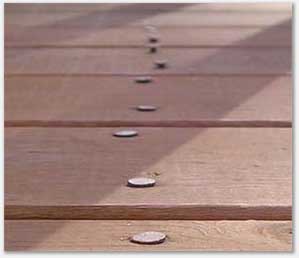 Decks
Decks
Most decks fail at attachment to the house. The ledger or rim should be bolted to the home. Check decking for any rot, loose rails, weak stairs, raised nail heads, posts, beams, joists and footings. Examine the paint/stain condition. Clean off any moss or slimy surfaces to help prevent slips. Spantex decking surfaces only last a few years without ongoing maintenance. Regular re- application of the color- top coat is recommended. Make sure all drains on impervious covered decks are clean and working. Even the best made deck will leak if it doesn't have working drains.
 Landscaping
Landscaping
It is recommended that all landscaping be trimmed away from the building. Nearly all homes we look at have at least some landscaping problems. Some kinds are more destructive then others, be especially careful with climbing vines. This time of year trees are filling our gutters faster than we can keep up. While it is beautiful, it can easily cause damage to your home in several ways. One often overlooked problem is that the plants make natural pathways for all kinds of household and structural pests.
Wednesday, August 22, 2007
Carpenter Ants, Part 2 in outr series on Structural Pests in the Northwest
Identification
 Carpenter Ants have a evenly curved "thoracic dorsum", this is the back of the insect. Then most common member of this family is Modoc, it is black with reddish colored legs, but color is not a good indicator as some types have red parts. These are often found moving along foraging lines about 1 foot apart Trees, fences and firewood are all regular paths for that they are known to use.
Carpenter Ants have a evenly curved "thoracic dorsum", this is the back of the insect. Then most common member of this family is Modoc, it is black with reddish colored legs, but color is not a good indicator as some types have red parts. These are often found moving along foraging lines about 1 foot apart Trees, fences and firewood are all regular paths for that they are known to use.
Damage in the Home
Carpenter ants will damage homes by nesting in them. The will dig out tunnels to in wood expand their living spaces and can lead to structural damage. They infestation in the home usually is a satellite colony, with the main one with in a hundred years or more in a stump or other decayed wood. When colonies start establish them selves in homes, they may start small, few hundred members but can grow to several tens of thousands. There can be 20 or more satellite colonies.
Making your Home Resistant to Carpenter Ants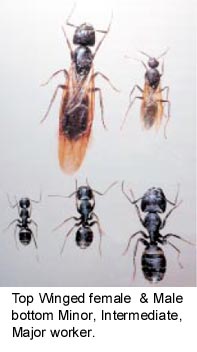
Stumps, fire wood:
Take care when storing firewood. This is a favorite nesting location for Carpenter ants. Always keep wood elevated and covered from the rain. A wet pile of firewood in contact with the ground is an ideal infestation location. Stumps left in the yard are common locations for colonies.
Landscaping:
Never allow plants to make contact with the home. Trees and shrubs provide natural paths for insects and are frequently foraging sites.
Wood/Soil contact:
It is a conducive condition for pests when wood touches soil. Wood should rest on concrete or other suitable support, and when it is in direct contact with the ground pressure treated lumber is recommended. Beauty bark or other landscaping is often piled too high next to homes. this can lead to rot/decay and lead to a carpenter ant infestation.
Ventilation:
Crawlspaces and attics need ventilation to keep the moisture content low. It the ventilation is not adequate, there will be biogrowth (mold, mildew or fungus) and create conditions that encourage infestations. Vapor barriers are recommended in crawlspaces. This will help keep the framing under the home dry and provide a barrier to discourage pests.
Points of Entry:
Check for hole in the exterior of the home. Where pipes and electrical wires enter. doors, windows, foundation cracks, siding and trim are all common locations for ants. Sealing these with caulk or other suitable materials with discourage entry.
Read more about Carpenter ants their control here:
WSU Extension Bulletin 0818.CARPENTER ANTS: THEIR BIOLOGY AND CONTROL, L. D. Hansen.
Carpenter Ant Update, PCT Magazine April 2002, L. D. Hansen.

If you find this information useful, don't keep us a secret! List us on any of your favorite networking / bookmarking sites

Tuesday, August 21, 2007
Zinsco Electric Panel Hazards
 Most have this silver foil label with the Zinsco name, others are called Magnetrip, others have the Zinsco name stamped in the enclosure. Never buy without an inspection, it could save your life. Really! See Cheryl's story here
Most have this silver foil label with the Zinsco name, others are called Magnetrip, others have the Zinsco name stamped in the enclosure. Never buy without an inspection, it could save your life. Really! See Cheryl's story hereZinsco electrical equipment is known to be hazardous for several reasons. There is a problem with the bus bar and breaker contact points arcing and overheating. Overheating the electrical contacts on breakers can destroy the integrity of this important safety item. Many reputably electricians won't service these anymore, and replacement is strongly recommended. They have been manufactured with aluminum bus bars as a clip on the breaker that make poor contact.

 Arcing has been observed in where these breakers contact the bus. This can result in the overheating and incapacitation of the breakers. We observed these breakers have their cases blow out and leave soot on the inside of the enclosures. Note the extensive soot inside this panel and inside the cover, this is a sure sign of overheating and is an extreme hazard.
Arcing has been observed in where these breakers contact the bus. This can result in the overheating and incapacitation of the breakers. We observed these breakers have their cases blow out and leave soot on the inside of the enclosures. Note the extensive soot inside this panel and inside the cover, this is a sure sign of overheating and is an extreme hazard.
 Sylvania/Zinsco
Sylvania/Zinsco
 These panels were also in later years manufactured by Sylvania. This is the Zinsco design and has the same reputation. The Sylvania like the Zinsco had the blue and foil label inside and colorful red, blue and green breakers. With the same flawed breaker and bus bar connection design. These panels are ones that we recommend replacement.
These panels were also in later years manufactured by Sylvania. This is the Zinsco design and has the same reputation. The Sylvania like the Zinsco had the blue and foil label inside and colorful red, blue and green breakers. With the same flawed breaker and bus bar connection design. These panels are ones that we recommend replacement.
Read more about Zinsco panels on Google here.
We recommend that anyone with one of these panels have them replaced as soon as possible.

If you find this information useful, don't keep us a secret! List us on any of your favorite networking / bookmarking sites

Monday, August 6, 2007
Moisture Ants, The First in our series on Structural Pests in the Northwest
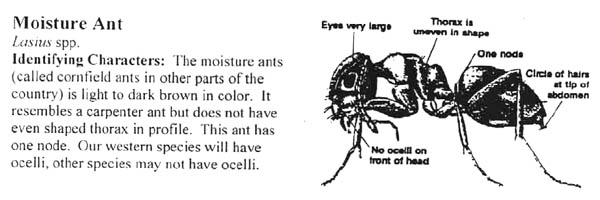
| The structural pests in the Northwest of greatest concern are all dependent on high moisture content in the wood.
Never buy a home without a complete wood destroying organism report
|
Tuesday, July 24, 2007
(FPE) Federal Pacific STAB-LOK Panels
The Federal Pacific Electric Stab-Lok panel is known among Electricians and Home Inspectors as a serious safety hazard. We wanted you to know that this reputation is well founded and documented by industry professionals & government agencies.

 To get the information necessary to write this article, we have done extensive research and made a Freedom Of Information Act request for the scientific documentation from the Consumer Product Safety Commission (CPSC). It took a couple of months to get a reply, and I was surprised to see the stack of information (approximately 300 pages ) documenting the hazards with Federal Pacific equipment.
To get the information necessary to write this article, we have done extensive research and made a Freedom Of Information Act request for the scientific documentation from the Consumer Product Safety Commission (CPSC). It took a couple of months to get a reply, and I was surprised to see the stack of information (approximately 300 pages ) documenting the hazards with Federal Pacific equipment.

 The failures documented were mostly concerning the FPE breakers failure to ‘trip’ at their rated amperage. Well documented CPSC studies show there is a failure to trip up to 60% of the time. This is a very high rate of failure, and is an unacceptable risk for any home owner.
The failures documented were mostly concerning the FPE breakers failure to ‘trip’ at their rated amperage. Well documented CPSC studies show there is a failure to trip up to 60% of the time. This is a very high rate of failure, and is an unacceptable risk for any home owner.
In many cases the breakers failed to properly turn off the power during an over current condition, often resulting in overheating and complete failure of the breaker to work at all. After an over current/over heating cycle, the breakers would frequently not turn off even if the breaker was manually flipped. This occurred in many breakers tested, purchased at several different sources, and different rated amperages.
There are also reports of problems with the bus and panels arcing resulting in fires. Do not accept replacement breakers, as there are significant hazards with the bus connections also
This poses a serious electric shock and fire hazard.
The CPSC reports conclusion stated "A significant number of the breakers tested are defective and do not provide the required level of protection..." "..the breakers themselves may develop hazardous behavior in the form of severe overheating or self-incapacitation in the on condition. The high failure rate of these breakers indicates serious deficiencies in the FPE quality control procedures, their product testing, and the UL follow-up testing program. The system of checks and balances which is supposed to prevent products with these levels of defect from ever being installed in electrical systems has, in this instance failed."
Read more about Federal Pacific Panel Hazards on Google
If you have a Federal Pacific panel, have it replaced as soon as possible!

If you find this information useful, don't keep us a secret! List us on any of your favorite networking / bookmarking sites

Sunday, June 3, 2007
Periodic Maintenance Tips for Your Home
A well maintained home will last longer, be a healthier place to live, maximizes the resale value, minimizes repairs costs, provides a more comfortable and safe living space. This article is a useful tool to help you maintain one of your most valuable assets. Set aside 2% or 3% a year of the homes value for the major repair expenses like water heaters, roofs, painting, floors, heating/cooling systems, gutter repairs etc.
Several times a year, during a hard rain, get an umbrella and see how your home and yard fairs in a downpour. Are the gutters working properly? Are the downspouts leaking or disconnected? Are they discharging water in working drains or splash blocks and carrying the water away from the structure? Is there water running towards the home or puddling next to the house? Is the grading of the soil proper to move excess water away from the home? Are there sidewalks or landscaping edging holding water next to the home? These are all major causes of water in crawlspaces and basements. Check basements for leaks and/or if possible, check crawlspaces to assure they are not accumulating excess water. Read more about keeping water out of your home here.
If possible, get into crawlspaces checking for moisture and other problems. This can be a dirty job but is probably the most important inspection you can do. If you are unable or unwilling to do this, I strongly recommend that you hire a professional to do it for you every couple of years or when you suspect a problem. If you detect any unusual odors, musty smells etc, this could indicate leaks in plumbing or water in crawlspaces.
 The insulation in this crawl space is upside down and falling off the joists |
Use a good quality dust mask and a strong flashlight. Take a camera with you so you can document any problems to show contractors what issues you may have. Look for all water lines and drains, carefully check around toilets, tubs and sinks for stains, leaks or rotten wood. Make sure the vapor barrier (plastic sheeting) is complete. There should be no bare earth, wood or paper debris.
Make sure vents are not blocked by landscaping or insulation. Examine the insulation to assure that it is not falling down and installed properly. If you can see a insulation that has a vapor barrier (paper or plastic sheeting) it must be facing the heated side. I can't tell you how many crawlspaces I go in that have the insulation upside down. If there is
duct work, check to see that it is properly connected and insulated. Check the walls for cracks and footings under posts for settlement. Check for any sign of pests (rodents, droppings, ants, termites etc)
Everyone should check the condition of their home, landscaping and retaining walls that affect the structure twice a year. Some of these items include the following:
Caulk and paint. I can't stress enough how important this is. Check the caulking around all doors, windows, trim, and utility holes. Check all windows for broken glass, cracks, broken seals or 'fogging', locking mechanisms and screens Check all doors for proper locks, weather stripping, thresholds and door sweeps. If you can see any daylight around a door you are going to pay for lost heat and in the long run that will pay for the proper
weatherization.
Check the stain or paint on decking surfaces, railings, steps etc., and examine the framing, posts and beams.
Trim all plants away from the building, decks, roofs and power lines.
Check plumbing fixtures and drains. Look for leaks under sinks and in vanities/cabinets.
Note trip hazards on drives, walks and patios. If they are getting worse, try to figure out why. Is the ground under them slipping, sinking or are there tree roots causing the problem? You should consider repairing them before someone trips and gets hurt.
|
|
Clean out gutters and check downspouts. Use extreme caution around overhead electrical wires, ladders and roofs! Do not take any unnecessary chances here please. If you are not comfortable doing this, have a professional do it for you. This is a good time to re-tar any patches on the roof. Tar lasts for a relatively short time and must be re applied regularly to prevent leaks. Check the roof for:
-
Gutter attachments, downspout mounts, splash block placements
-
Fasteners that penetrate the roof, re-apply tar as needed
-
Missing shingles, conditions of valleys and ridges,
flashings, check condition of tar dots on the nails -
Attic and plumbing vents and fasteners. Tar as needed
-
Flashings around chimneys
-
Soft sheeting, roof warping or 'wow' of the roofing planes
|
|
Inspect the attic, looking for :
-
Disconnected exhaust vents, heating
duct work -
Moisture stains, mold/mildew/fungus growths, address excessive moisture
problems promptly -
Broken framing or
delaminated sheeting -
Blocked vents, broken vent screens and any signs of birds or pests
Check all stairs for
-
Good lighting
-
Bouncy or poor framing, loose treads, etc.
-
Hand rails should be solid, easy to grip, proper height (about 32" above stair nose) with no openings greater then 4"
Fireplaces
-
If you have a
wood burning insert, stove or fireplace and use it regularly have the flue examined and cleaned once a year -
Examine the chimney crown and fire brick for excessive cracking
-
Check the flashing and
counterflashing to see they are in good order -
Be sure you have a carbon monoxide detector installed
Furnace/AC
-
Replace filters, if you have one, clean electrostatic air cleaners
-
Oil furnaces should be 'tuned up' by a professional every year or 2
-
Turn off the power and vacuum electric wall heaters, the dust
buildup can cause sparks and burning debris to be ejected upon start up -
Check A/C hose insulation. Keep landscaping and debris away from exterior heat pumps and A/C compressors
Laundry
-
Look behind dryers and check for lint accumulation or kinked/crushed vent hoses. Repair or replace as needed
-
Outside vents, clean lint accumulations
-
Check washing machine hoses, some manufacturers recommend replacing them every few years.
|
|
Hot water heaters
-
Look for leaks at the supply lines, shutoff valves, over
pressure/temperature valves -
If in an unheated space, insulating the tank will save you money
-
If a gas unit, check for exhaust
rollout stains and earthquake straps. See the photo to the left -
Smell around the gas supply lines and thermostat to check for leaks.
Electrical checks
-
Check power cords
-
Extension cords, discard/properly repair any that are worn of have broken insulation
-
Test all GFCIs and if your electrical panel has them arc fault interrupters. These fail regularly and are very important safety devices
-
If any breakers or fuses need regular resetting/replacement, have a electrician check them out
Smoke and CO Detectors
Check all smoke detectors, replacing batteries regularly. Most homes have smoke detectors but many have batteries that are dead. If you have an attached garage or any appliances, furnaces, fireplaces etc. that use natural gas, oil, wood, kerosene or any combustible material, please get a carbon monoxide detector. They are not the same thing as a smoke detector! Some units are combo smoke and CO detectors, but not usually. We can usually smell smoke but there is often no way to detect carbon monoxide until a hazardous condition exists in the home. Read an article we wrote about carbon monoxide hazards here

If you find this information useful, don't keep us a secret!
List us on any of your favorite networking / bookmarking sites

Thursday, May 10, 2007
Precision Tools for the Best Inspections
Computerized reports - Our reports are easy to read and published to the Internet. See a sample here. This allows easy sharing of the information with sellers or contractors. We tried many reporting systems and found them incomplete, hard to understand and lacking in useful information. After extensive research and months of development, we created our own complete home inspection reporting system. Ours is fully web interactive, with extensive linking to the Internet for further explanation of the issues. You wont find it anywhere else!
Digital photography - We take pictures of all critical elements during your inspection and are experts in the fine art of digital photography. By using proper lighting, composing the subject and editing on-site (cropping, brightness, contrast, fill light and annotating) we make the most out of this valuable tool. You know what they say, a picture can be worth 1000 words, especially for buyers that are out of town or otherwise can't be at the inspection personally. All our work is published to the web in minutes after the inspection on a customized web page for each customer. See a sample photo web page here.
Mobile office equipment - We bring a mobile Internet connection to every job. This not only allows us to publish your reports in minutes, but gives us the ability to deliver further documentation to our customers on what we find. One example of this was a home that had a problematic electrical panel. When we told the buyers and seller about this, they were both quite upset. The buyer demanded something be done about the panel and the seller refused (he had built the house himself and never had a problem with it). Since we had the ability to print the documentation on that particular panel on-site, we defused this contentious issue on the spot, and the seller made the recommended safety repair concession to the buyer.
High speed color printer - Our blazing fast printer can print our entire 38 page report in under 3 minutes in full color!
Wood Destroying Pest ID Lab - We bring our lab equipment to every inspection, including microscope, insect collection tools, magnifying glasses, test tubes, identification charts/diagrams, and sample insects for comparisons. We make every effort to identify inspects on-site and provide our customers with advice in dealing with them. We are members of Washington Pest Control Association and routinely send samples of insects and insect damage to WSU entomologists for identification verification.
Specialty Inspection Equipment-Better Tools Mean Better Inspections
We use precise diagnostic tools to detect problems and advise on how to correct them. Without investing in the best tools, you are not giving the client the best inspections. Some of ours include:
Fluke Digital Multi-meter instead of an outlet tester, a multi-meter gives a much better indication of your electrical systems condition.
Flammable Gas Detector to locate natural gas, propane and other dangerous gasses.
Moisture Meter detects moisture under floors and behind walls.
Laser thermometer - for checking heating, cooling, refrigeration, and looking for faulty electrical systems.
Fluke Digital Multi-Meter Most inspectors use simple outlet testers. While there are useful tools, (we have them too) our multi-meter can tell you so much more. This tool costs more, a lot more (70 times the cost of our outlet testers) and it is worth every penny!
Most inspectors use simple outlet testers. While there are useful tools, (we have them too) our multi-meter can tell you so much more. This tool costs more, a lot more (70 times the cost of our outlet testers) and it is worth every penny!
We test the voltage of every panel that we inspect. It is also possible to detect many other conditions such as bad breakers, loose connections, over or under voltage supplies to name a few. This kind of thorough check of your electrical system is a standard part of our inspection service. Most inspectors don't have the equipment or training to perform these tests, but we do.
This is just one of the value added checks we perform. When we do find a problem, JJ's background in actually installing electrical panels, wiring, heaters, outlets, appliances and lighting circuits mean that we can pass you advice that most inspectors can't. In the event of a problem, we have a great electrical contractor that we have been working with for 25 years, and happy to recommend them to our customers.
Features of our fluke meter include: True RMS voltage and current measurements, 0.09% basic accuracy, 6000 count resolution, Digital display with analog bargraph and backlight, Manual and automatic ranging, Display Hold and Auto Hold, Frequency and capacitance measurements, Resistance, continuity and diode measurements, Min-max-average recording, Smoothing mode allows filtering of rapidly changing inputs, Closed case calibration through front panel, Ergonomic case with integrated protective holster, EN61010-1 CAT III 1000V / CAT IV 600V, Measures twice as fast as other multi-meters
Moisture Meter This tool is used to assess the relative moisture level of building materials such as wood, plaster, sheetrock, masonry, concrete and behind coverings like ceramic tile and vinyl floors. It is great for checking relative moisture conditions of building components in walls and floors. When we see a suspect stain on a ceiling or wall we can verify if it is old or still has high moisture content. This tool gives our customers extra peace of mind and security in our inspection process.
This tool is used to assess the relative moisture level of building materials such as wood, plaster, sheetrock, masonry, concrete and behind coverings like ceramic tile and vinyl floors. It is great for checking relative moisture conditions of building components in walls and floors. When we see a suspect stain on a ceiling or wall we can verify if it is old or still has high moisture content. This tool gives our customers extra peace of mind and security in our inspection process.
Features include: Detects moisture directly in materials and below wall and floor coverings such as tile, wood and vinyl. - Reset reading for sensitivity adjustment - Not adversely affected by surface moisture such as condensation. - Dual Display LCD and LED. - Color changing LED’s to show moisture condition.
TIF Combustible Gas Detector
 Whenever we have a gas appliance, it is checked for leaks. This is extremely sensitive, and we only report leaks that are also verified by smelling them also. This is very expensive tool, and not all inspectors use them. We do, and make every effort to keep you and your family safe from the real risks associated with gas leak hazards.
Whenever we have a gas appliance, it is checked for leaks. This is extremely sensitive, and we only report leaks that are also verified by smelling them also. This is very expensive tool, and not all inspectors use them. We do, and make every effort to keep you and your family safe from the real risks associated with gas leak hazards.
Features include:
Ultimate sensitivity 5 – 50ppm Checks for explosive gas in places where electrical measurement has to be taken - Warns against dangerous explosive gas - Instantaneous response - Used in almost any situation where combustible gasses, vapor or residues need to be found - Automatic warm up - Adjustable sensitivity - Audible “Geiger counter” type signal
Some of the detectable compounds are:
Acetylene, Iso-Butane, Methane, Ethane, Propane, Ethylene, Hydrogen, Methyl Ether, Vinyl Chloride, Methyl Chloride, Hydrogen Sulfide, Acetone, Methanol, Ammonia, Gasoline, Chlorine


 This moisture can come from rain, soil, water supply lines and drains. All these possible sources need to be addressed or there will certainly be a problem. Around here, keep it dry and them pests will usually keep away. This is a picture from under a toilet. We checked it before we got in the crawlspace, and noted that it was loose. This nearly always leads to leaks and if not promptly addressed, wood decay. Such leaks are sometimes not so obvious especially if there is insulation and or wall-board installed.
This moisture can come from rain, soil, water supply lines and drains. All these possible sources need to be addressed or there will certainly be a problem. Around here, keep it dry and them pests will usually keep away. This is a picture from under a toilet. We checked it before we got in the crawlspace, and noted that it was loose. This nearly always leads to leaks and if not promptly addressed, wood decay. Such leaks are sometimes not so obvious especially if there is insulation and or wall-board installed. This is
This is 







